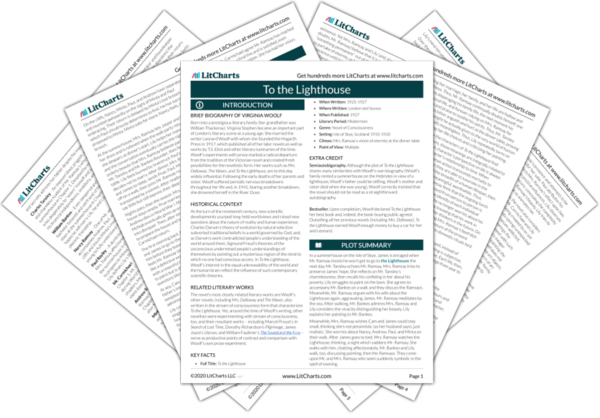Summary
Analysis
With James gone, Mrs. Ramsay relishes being alone. Her whole being “shrunk, with a sense of solemnity, to being oneself, a wedge-shaped core of darkness, something invisible to others” and experience starts to seem gloriously “limitless.” She imagines everyone must have “this sense of unlimited resources” in solitude and imagines them saying, “the things you know us by are simply childish. Beneath it all is dark…unfathomably deep.” Alone without “personality,” she is free of “fret, the hurry, the stir,” and feels triumphant. Looking at the world at such times she “became the thing she looked at,” and at this moment feels herself one with the Lighthouse.
Alone and thus free of a social context to define her, Mrs. Ramsay feels excitingly shapeless and invisible. She feels unlimited by external expectations and feels her deepest self (and by extension everyone’s deepest self) is capable of anything. This portrait of the interior self combines contradictory qualities: it is shrunken to the point of being invisible and expanded to encompass “unlimited resources.” As her deepest self, Mrs. Ramsay feels united with the Lighthouse, the symbol of human desire.
Themes
Quiz
Test Yourself
Mrs. Ramsay’s mind cycles loosely through snippets of phrases, but when it suddenly alights on the phrase, “We are in the hands of the Lord,” Mrs. Ramsey is irritated with herself feeling “trapped into saying something she did not mean.” She reflects that she has never believed a Lord made the world and has always been conscious of humanity’s senseless suffering. Mr. Ramsay passes by and, seeing her face engaged in this thought, sees “the sternness at the heart of her beauty.” Her distance pains him, as does his helplessness to assist her and shame that he in fact makes things “worse for her” by being “irritable.”
Mrs. Ramsay pointedly rejects the sorts of meanings religion ascribes to life. Her interior reflection on the inadequacy of religion expresses itself externally as a stern expression on her face, which Mr. Ramsay, in turn, interprets as evidence of his wife’s distance from him and his inability to help her.
Themes
Quiz
Test Yourself
Mrs. Ramsay as always emerges from solitude by “reluctantly…laying hold of some…sound, some sight.” She looks at the Lighthouse light and, still thinking how it is “so much her, yet so little her” and feels it is “stroking…some sealed vessel in her brain whose bursting would flood her with delight.” She feels she has “known happiness…and it silvered the rough waves a little more brightly,” and she is overcome with a contented joy.
Sensory perceptions of the exterior world help Mrs. Ramsay extract herself from her interior life. Still, the joy she’s accessed through interior meditation extends out into the exterior world around her and beautifies her vision of the sea.
Themes
Quiz
Test Yourself
Mr. Ramsay, all the while, is admiring Mrs. Ramsay’s beauty but resolving not to interrupt her, despite feeling injured by her distance. Then, Mrs. Ramsay rises and goes to him, giving “of her own free will what she knew he would never ask…For he wishes, she knew, to protect her.”
Though he craves his wife’s attention, Mr. Ramsay restrains himself out of respect for her. Knowing her husband’s feelings just from looking at him, Mrs. Ramsay goes to her husband to comfort him by letting him feel he can comfort her.
Themes
Quiz
Test Yourself
Get the entire To the Lighthouse LitChart as a printable PDF.













